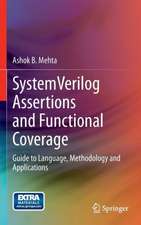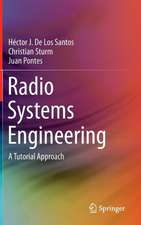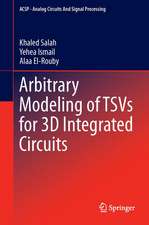BioMEMS: Microsystems, cartea 16
Editat de Gerald Urbanen Limba Engleză Hardback – 5 mai 2006
Here, a new discipline evolved which focuses on microsystems for living systems called "BIOMEMS". In this review at a glance the exciting field of bio-microsystems, from their beginnings to indicators of future successes are presented. It will also show that a broad penetration of micro and nano technologies into biology and medicine will be mandatory for future scientific and new product development progress in life science.
Toate formatele și edițiile
| Toate formatele și edițiile | Preț | Express |
|---|---|---|
| Paperback (1) | 1099.73 lei 6-8 săpt. | |
| Springer Us – 29 noi 2010 | 1099.73 lei 6-8 săpt. | |
| Hardback (1) | 1111.09 lei 6-8 săpt. | |
| Springer Us – 5 mai 2006 | 1111.09 lei 6-8 săpt. |
Din seria Microsystems
- 18%
 Preț: 941.05 lei
Preț: 941.05 lei - 15%
 Preț: 640.55 lei
Preț: 640.55 lei - 5%
 Preț: 1105.04 lei
Preț: 1105.04 lei - 15%
 Preț: 643.34 lei
Preț: 643.34 lei - 15%
 Preț: 639.73 lei
Preț: 639.73 lei - 18%
 Preț: 952.72 lei
Preț: 952.72 lei - 18%
 Preț: 950.03 lei
Preț: 950.03 lei - 18%
 Preț: 951.29 lei
Preț: 951.29 lei -
 Preț: 430.69 lei
Preț: 430.69 lei - 20%
 Preț: 1000.38 lei
Preț: 1000.38 lei - 15%
 Preț: 640.06 lei
Preț: 640.06 lei - 18%
 Preț: 952.72 lei
Preț: 952.72 lei - 15%
 Preț: 638.76 lei
Preț: 638.76 lei - 15%
 Preț: 640.71 lei
Preț: 640.71 lei - 15%
 Preț: 638.57 lei
Preț: 638.57 lei - 15%
 Preț: 640.37 lei
Preț: 640.37 lei - 15%
 Preț: 638.43 lei
Preț: 638.43 lei - 15%
 Preț: 643.34 lei
Preț: 643.34 lei - 18%
 Preț: 954.77 lei
Preț: 954.77 lei
Preț: 1111.09 lei
Preț vechi: 1169.56 lei
-5% Nou
Puncte Express: 1667
Preț estimativ în valută:
212.67€ • 231.09$ • 178.76£
212.67€ • 231.09$ • 178.76£
Carte tipărită la comandă
Livrare economică 21 aprilie-05 mai
Preluare comenzi: 021 569.72.76
Specificații
ISBN-13: 9780387287317
ISBN-10: 0387287310
Pagini: 365
Ilustrații: XIX, 365 p.
Dimensiuni: 210 x 297 x 21 mm
Greutate: 0.84 kg
Ediția:2006
Editura: Springer Us
Colecția Springer
Seria Microsystems
Locul publicării:New York, NY, United States
ISBN-10: 0387287310
Pagini: 365
Ilustrații: XIX, 365 p.
Dimensiuni: 210 x 297 x 21 mm
Greutate: 0.84 kg
Ediția:2006
Editura: Springer Us
Colecția Springer
Seria Microsystems
Locul publicării:New York, NY, United States
Public țintă
ResearchCuprins
- EARLY BIOMEMS, MULTI-SENSOR NEUROPROBES. 1. INTRODUCTION . 2. EVOLUTION OF MICRO-SENSOR ARRAY DESIGNS FOR MEDICAL RESEARCH. 2.1.Electrical signal monitoring. 2.2.Sensor Design Evolution: from 2D to 3D. 2.3.Chamber-Type Electrochemical Oxygen Sensors. 3. OTHER APPLICATIONS – THE FIRST MICRO-FLUIDIC DEVICE. 4. CONCLUSION. 5. REFERENCES.- MULTI-PARAMETER BIOMEMS FOR CLINICAL MONITORING. 1. INTRODUCTION. 2. BIOSENSORS. 2.1.Principle of Biosensors. 2.2.Amperometric Biosensors. 2.3.Aspects of miniaturization and integration. 3. CLINICAL MONITORING. 3.1.Multi-analyte measurement. 3.2.Microdialysis. 3.3.BioMEMS for clinical monotoring. 3.4.Multiparameter monitoring. 3.5.Applications.. 4. CONCLUSIONS AND OUTLOOK. 5. REFERENCES.- BIOMEDICAL MICRODEVICES FOR NEURAL IMPLANTS. 1. INTRODUCTION TO NEURAL IMPLANTS. 2. ANATOMICAL AND BIOPHYSICAL FUNDAMENTALS. 2.1.Peripheral Nerve Anatomy. 2.2.Mechanisms of Peripheral Nerve Damage. 2.3.Excitability of Nerves. 2.4.Electrical Modeling of the Nerve Membrane. 2.5.Propagation of Action Potentials. 2.6.Extracellular Stimulation of Nerve Fibres. 2.7.Selective Activation of Nerve Fibres. 3. CLINICAL IMPLANTS. 3.1.Electrodes – The Key Component in Neural Prostheses. 3.2.Cardiac Pacemakers. 3.3.Implantable Defibrillators. 3.4.Cochlea Implants. 3.5.Phrenic Pacemakers. 3.6.Grasp Neuroprostheses . 3.7.Neuroprostheses for gait and posture. 3.8.Spinal Root Stimulator. 3.9.Drop Foot Stimulator. 3.10.Neuromodulation. 3.11.Deep Brain Stimulation. 3.12.Vagal Nerve Stimulation. 4. THE CHALLENGE OF MICROIMPLANTS. 5. VISION PROSTHESES. 5.1.Cortical Vision Prostheses. 5.2.Optic Nerve Vision Prosthesis . 5.3.Retinal Implants. 5.4.Conclusions on Vision Prostheses. 6. PERIPHERERAL NERVE INTERFACES. 6.1.Non-Invasive Nerve Interfaces. 6.2."Semi"-Invasive Interfaces. 6.3.Invasive Interfaces. 6.4.Biohybrid Approaches. 7.FUTURE APPLICATIONS. 7.1.Interfacing the Brain. 7.2.Spinal Cord Implants. 7.3.Multimodal Neural Implants. 8.CONCLUDING REMARKS. 9.NEURAL IMPLANTS: BOON OR BANE? 10. REFERENCES.- MICROFLUIDIC PLATFORMS . 1.INTRODUCTION. 2. WHAT IS A MICROFLUIDIC PLATFORM. 3. EXAMPLES OF MICROFLUIDIC PLATFORMS. 3.1.PDMS based Microfluidics for Large Scale Integration ("Fluidigm platform"). 3.2.Microfluidics on a Rotating Disk ("Lab-on-a-Disk"). 3.3.Droplet based microfluidics (DBM). 3.4.Non-contact liquid Dispensing. 4.CONCLUSION. REFERENCES.- DNA BASED BIO-MICRO-ELECTRONIC-MECHANICAL-SYSTEMS. 1.INTRODUCTION. 1.1.The unique features of nucleic acids. 1.2.Lab-on-the-Chip. 1.3.Biochemical reaction chains for integration: biosensors and the "lab-biochip". 2.MICROARRAYS AND BIOCHIPS BASED ON DNA. 2.1.The typical microarray experiment. 2.2.Manufacturing of Microarrays. 2.3Transcription Analysis. 2.4.Oligonucleotide Arrays for sequencing. 2.5.Active arrays. 2.6.Integrated PCR. 3. NANOBIOTECHNOLOGY: DNA AS MATERIAL. 3.1.DNA directed immobilisation and nucleic acid tags. 3.2.DNA for regular structures. 3.3.DNA to structure surfaces. 3.4.Metallisation of DNA for electronic circuits. 4.REFERENCES SEPARATION AND DETECTION ON A CHIP. 1.INTRODUCTION. 2.THEORY OF CAPILLARY ELECTROPHORESIS ON A CE-CHIP. 2.1.Mobility of ions. 2.2.Electroosmotic flow. 3.JOULE HEATING IN MICROFABRICATED DEVICES. 3.1.Separation efficiency of a CE-chip. 3.2.Separation of biomacromolecules and particles. 4.BUILDING BLOCKS OF CE-CHIP DEVICES. 4.1.Wafer materials, micromachining and wafer bonding. 4.2.Power supplies, pumping, injection and channel geometries. 4.3.Detection strategies. 5.SELECTED EXAMPLES FOR CE ON A CHIP. 6.DIELECTROPHORESIS. 7.OUTLOOK. 8.REFERENCES.- PROTEIN MICROARRAYS : APPLICATIONS AND FUTURE CHALLENGES. 1.INTRODUCTION. 2.FORWARD-PHASE PROTEIN MICROARRAYS. 2.1.Protein-Expression Analysis Using Protein Microarrays. 2.2.Protein Interaction Microarrays. 3.REVERSE MICROARRAYS. 4.OUTLOOK. 5.BIBLIOGRAPHY .- LAB-ON-A-CHIP SYSTEMS FOR CELLULAR ASSAYS . 1.INTRODUCTION . 2.DESIGN AND FABRICATION OF CHIPS FOR CELL BASED ASSAYS. 3.CELL CULTURE ON CHIPS AND MICROFLUIDIC SYSTEMS. 4.DETECTABLE CELLULAR OUTPUT SIGNALS. 4.1.Cell Metabolism. 4.2.Cell Morphology. 4.3.Electrical Patterns. 5.CELL MANIPULATION ON CHIPS. 6. CONCLUSIONS AND FUTURE PROSPECTS.- NETWORK ON CHIPS. 1.INTRODUCTION. 2.TECHNICAL ASPECTS AND UNDERLYING ASSUMPTIONS. 2.1.System requirements. 3.ORIGIN OF THE SIGNAL RECORDED. 4.SPATIAL RESOLUTION. 5.LFP AND PLASTICITY. 6.NETWORK DYNAMICS AND EPILEPTIFORM ACTIVITY. 7.DRUG TESTING WITH MEAS. 7.1.Using Network Properties as Endpoints in Drug Assays. 7.2.Assessing Distributions of Neuronal Responses to Dopamine. 7.3.Cardiopharmacology. 8.DATA ANALYSIS. 9.OUTLOOK.- BIONANOSYSTEMS. 1.INTRODUCTION. 2.BASIC CONCEPTS AND EXPERIMENTAL METHODS. 2.1.Self-assembly. 2.2.Optical properties of semiconducting nanocrystals. 2.3.Optical properties of metal nanocrystals. 2.4.Magnetic nanoparticles. 2.5.Conjugation of nanomaterials and biomolecules. 2.6.Bioanalysis with bionanosystems. 2.7.Imaging. 3.APPLICATIONS. 3.1.DNA detection. 3.2.Immunoassays. 3.3.Imaging. 4.CONCLUSION AND OUTLOOK. 5.ACKNOWLEDGEMENTS . 6.REFERENCES.
Recenzii
"It wasn't too long ago that BioMEMS and its impact could be treated in one or two modest chapters of a general book on MEMS. No longer. From DNA analysis to retinal implants to artifically created networks of neurons, this field has simply exploded. Dr. Urban and his contributors have created a welcome and urgently needed digest of this diverse and exciting field, supported by extensive citations to the relevant original work. Every researcher in BioMEMS, and every student hoping to work in this field, will need this on his or her desk."
Stephen D. Senturia, Prof. of Electrical Engineering, Emeritus Massachusetts Institute of Technology, MIT
Stephen D. Senturia, Prof. of Electrical Engineering, Emeritus Massachusetts Institute of Technology, MIT
Caracteristici
Dealing with this topic in general Gives a comprehensive overview Teaches basics of Biomems Introduction and outlook of a new scientific avenue Combination of biology/medicine and Microsystems Technology
















